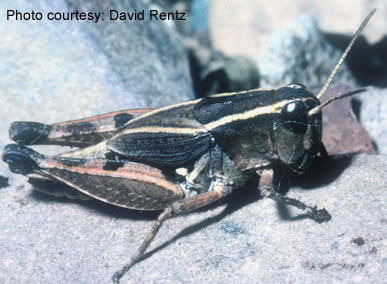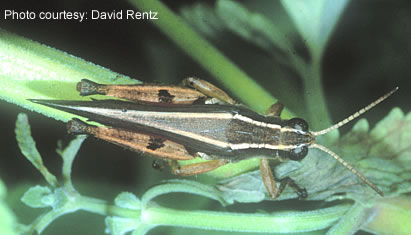
Short winged morph of an adult Wingless grasshopper

Long winged morph of an adult Wingless grasshopper
Note: Wingless grasshopper is not described in the "Field Guide to the Locusts and Related Grasshoppers of Australia" booklet available from the APLC.
Size: Female 18 mm, male 13 mm long.
Adult Description: Colour variable, ranging from dark grey to brown but never green. Five colour-pattern forms exist; about 6% of adults of both sexes have a distinct white lateral body stripe (see above). The thighs (femora) of the hind (jumping) legs have a distinct black mark mid way along their length. Wingless grasshoppers are slender in appearance; their thoraxes are straight in profile while those of Australian plague locust and Austroicetes are typically saddle-shape in profile. Wingless grasshoppers have a flat, pointed peg on their throats; Australian plague locust and Austroicetes do not have pegs on their throats.
Confusion with Australian plague locust and Austroicetes: Wingless grasshoppers are sometimes found in association with a range of other species such as Yellow winged locust, Eastern plague locust, Yellow bellied grasshopper, Mountain brown, Small plague grasshopper (Austroicetes cruciata) and occasionally Australian plague locust. Adult wingless grasshoppers can be readily distinguished from the adults of the latter two species on the basis of their colouration, markings and the lack of a white ‘X’-shaped marking on top of the thorax. Some confusion may arise because the shanks (tibiae) of the hind legs of wingless grasshopper are orange in colour while those of the Australian plague locust and some species of Austroicetes are reddish to pinkish in colour. However, the shanks of wingless grasshoppers do not have a pale-coloured collar while those of the other two genera do. The short-winged adult form of the wingless grasshoppers is sometimes confused with late instar nymphs of these and other species of grasshoppers (compare images given in Identifying wingless and winged species). However, examination of the direction of the wing venation on the wingbuds and the markings on the thorax will readily distinguish this species. Wingless grasshoppers do not eat grasses - only native and introduced forbs.
Unique features: There are two morphological forms (morphs) of this species. The short wing characteristic gave rise to the common name Wingless grasshopper. Approximately 60% of adults have short wings (and are unable to fly; a condition also known as brachypterous) and a variable proportion of adults have long wings (and are able to fly; a condition known as macropterous). Boths morphs are shown in the images above.
Further information on this species:Description of nymph
